
Tobacco and Medicine Menu: 1 2 3 4 5 6 7 8 9 10 11 12 13 14 15 Next>>
Tobacco and Medicine During the Golden Age of Piracy, Page 7
Tobacco Use and Tools - Pipes and Pipe Paraphernalia, Continued
GAoP Era Pipe Paraphernalia
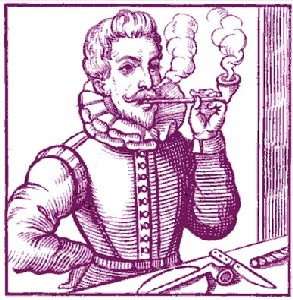
Smoking Tools on Table - Pipe, Knife and Tobacco Roll,
From Tobacco Its History and Associations, p. 57 (1862)
There were a number of peripheral items associated with English pipe smoking. One of these items was a tobacco container - the box or pouch discussed previously.
In addition, a pipe smoker would have a knife or some similar implement to cut tobacco off the end of the twist or carot which would then be placed in the pipe or stored in the box for later use. Since any blade could be used for this purpose, the knives were not preserved as specific to use with tobacco like some of the other tobacco implements have been. However, they can be seen in some images from around this time. Antiquarian Frederick William Fairholt discusses in reference to an image included in his book, seen at left. Fairholt explains, that the image is "copied from a rare little volume in 12mo, printed at Rotterdam in 1623, and entitled, Een Korte beschryvinge van het wonderlycke kruyt Tobacco. The engraving is valuable for the clear way in which it depicts the whole paraphernalia of a smoker, with the roll of Tobacco on the table before him, and the knife and trencher [plate] with which he cuts it up for use."1
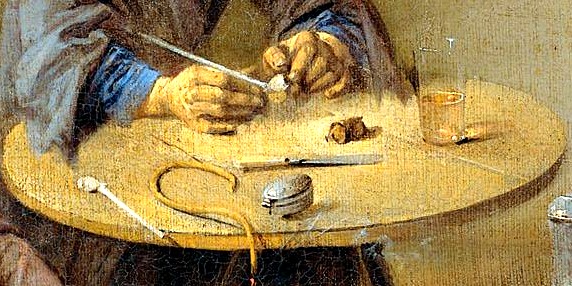
Artist: Abraham Diepraam
Smoking Paraphernalia: (from left) - Pipe, Slow Match, Silver Tobacco Box, Knife and Tobacco Carot,
From The Barroom,
Currently in the Rijksmuseum (1665)
Another image, a bit closer to the golden age of piracy showing a knife for use with tobacco comes from Dutch Golden Age painter Abrahm Diepraam. This images shows a few other implements in conjunction with tobacco use including a silver tobacco box and a slow match - a piece of cord which is treated to make it burn slowly and consistently. It was originally used to fire ordnance, but would also serve as an admirable tool for lighting pipes if there were several to be lit. These have the added benefit of being available on most ships.
Another device that might be used to light a pipe were tobacco tongs. 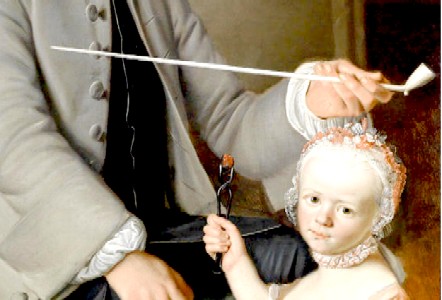
Artist: Sigmund Barth
Using Tobacco Tongs to Hold a Hot Coal, Porträt eines Vaters mit seiner Tochter (1765) Berthold Laufer explains them simply: "Silver tongs, called ember-tongs or brand-tongs, were used in lifting the hot charcoal to light the pipe."2 Philip Ashton, who escaped from Edward Low's crew to Roatán island (off what is today Honduras) in 1723, met a fellow castaway after a few months who left him with, among other things, "a Knife, a Bottle of Gun-Powder, Tobacco, Tongs, and Flint, by which means I was in a Way to live better than I had done."3 Simple tobacco tongs can be seen in the image at left.
Even more interesting are small 17th century tobacco tongs which were referred to as a smoker's companion. This had a spring to keep the jaws clamped firmly on the red hot coal and were small enough that they might be carried in the user's pocket. Sara Rivers Cofield provides an in depth look at these devices with an excellent diagram of the device. Jim Miller wrote an interesting article on how he went about recreating one.
Philip Ashton brings up another item that might be helpful in lighting a pipe: a flint. When flint is struck against carbon steel or iron carbite, sparks are generated. Such a method would 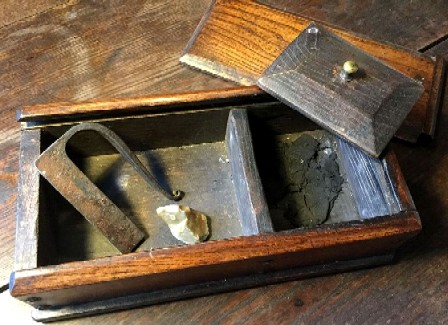
Photo: Wiki User Boldivio
A Large 18th Century Wooden Tinder Box Containing a Steel Fire Striker, Flint and Char Cloth probably not be used to light pipes directly without some difficulty, as anyone who has used flint and steel to light a fire can attest. Metal 'fire strikers' were often kept in tinderboxes along with a piece of flint and tinder. Large boxes such as the one seen at right would be kept in a house or possibly on a ship for lighting fires for cooking and warmth when possible. (Ships often did not allow fires to be lit when they were traveling due to the risk of fire which could be disastrous in the wooden world.) Smaller, pocket-sized versions could be carried about as well.
When pirates Phineas Bunce and Dennis Mccarty caused a mutiny among a group of ships on a trading mission from Providence, Bahamas, Richard Turnley "resolved to go shore... rather than engage with the pirates, and [another man] hearing him say, that they could find food to keep them alive, if they had but fire to dress it, privately gave him a tinder box with materials in it for striking fire; which; in his circumstances, was a greater present than gold & jewels."4 Captain George Roberts used another method for starting a fire after being set free by Edward Low's pirates with only his ship and a few miscellaneous items on board. "I struck a Light by Help of the old Gun that [Low's companion ship Captain John] Russel gave me at parting, which I then thought a useless Present, and accepted it only, because I durst do no otherwise; but having neither Tinder-Box, nor Steel left me, it would have been impossible for us to get Fire without it"5.
Tinder was another invaluable element in the tinderbox, important enough to have lent its name to the container. 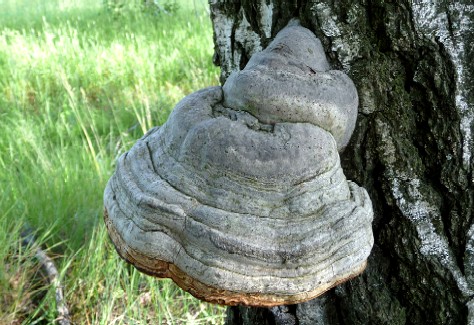
Photo: George Chernilevsky - Fomes fomentarius aka. Tinder Fungus Tinder is "any thing eminently flammable placed to catch fire"6, which explains why it is kept in a separate compartment in the tinderbox shown previously. The material in the image appears to be char cloth, which is made from cloth such as linen or cotton. It is put in a tin container with a small hole in it, and heated in coals until the the cloth is charred. It can then be lighted with a single, small spark and will burn slow and hot. This makes it ideal for use with a flint and tinder.
Other rapid lighting materials will also serve as good tinder. In the second edition of his book on trees produced for the British Navy called Sylva, English author John Evelyn suggests using fungus as tinder.7 Captain George Roberts mentions that the silk-cotton tree (Ceiba pentandra) "makes the best Tinder of any thing that I know of in the World"8. Pirate biographer Charles Johnson states that the 'cabbage' (hearts of palm) found at the top of the cabbage-palm (probably Euterpe edulis) is covered with "a Down that makes the best of Tinder"9.
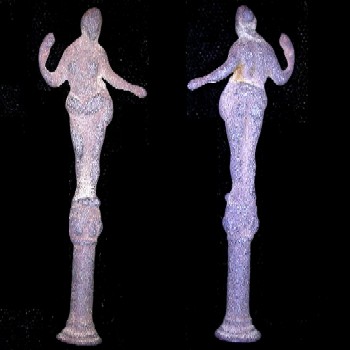
Photo: Wendy Scott
Female Figure Pipe Tamper, Made From Copper Alloy,
From The Portable Antiquities Scheme (c. 1650-1900) Many pipe smokers also used pipe stoppers, also called pipe tampers. Laufer explains that when tobacco was expensive, "smokers were economic and burned their tobacco to the very bottom of the bowl, pressing the ashes down by means of a stopper."10 William Chatto suggests that tobacco tampers were the only smoking device where "anything like taste or fancy displayed. This was the only article on which the English smoker prided himself. It was made of various materials— wood, bone, ivory, mother-of-pearl, brass, and silver; and the forms which it assumed were exceedingly diversified."11 Fairholt says that "[m]any cheap tobacco-stoppers were cut in hard wood, some few in mahogany; but by far the greatest number were cast in brass"12. Fairholt also explains that tobacco tampers or stoppers were sometimes made from something of importance to the smoker. "A tree planted by a great man, a fragment of a celebrated ship, a beam of an historic mansion, were each taxed for a tobacco-stopper."13
He points to a "bear's tooth tipped with silver at the bottom, and inscribed with the name of Capt. James Rogers, of the Happy Return, whaler, 1688" as well an ivory carving of Dr. Henry Sacheverel from 1710.14 Fairholt describes a variety of tobacco tampers which he identifies as being from around the time of the golden age of piracy. He pictures several in his book as seen below. Fairholt notes that these were all cast in brass, adding, "Busts of a grotesque kind were general favourites, or figures of a jolly sailor; but a very large number took the form of the human leg or arm, which was fabricated as if bent, and made a very useful implement."15
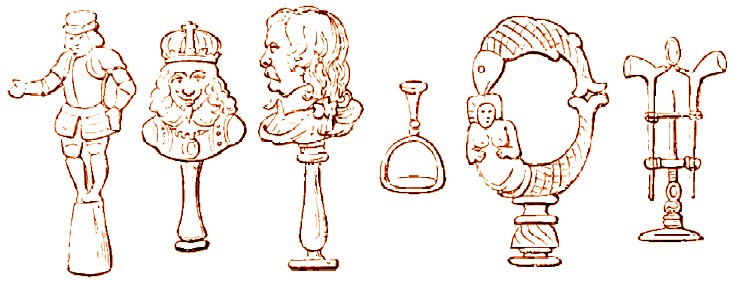 Fanciful Tobacco Stoppers or Tampers, (from left): A Soldier in Armor from the Time of James or Charles I, A Bust of Charles I, A Bust of Oliver Cromwell, a Ring Tamper For Wearing on the Finger, the "device of an old sailor" and a Pipe Rack Where "The stopper is formed of a twopenny piece of Queen Anne." Quoted Text and Images From Tobacco Its History and Associations, pp. 234-6 (1862) |
Pick picks were another implement in use during the golden age of piracy, although they were not quite
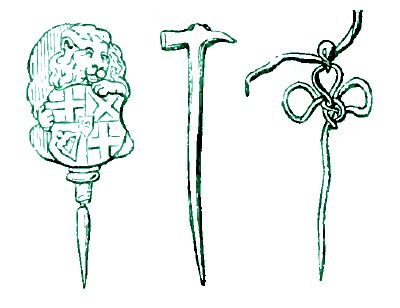
Pick Picks, From Tobacco Its History and Associations, p. 193 & 235 (1862)
as intricate or interesting as the tobacco tampers. Fairholt says that these were used "to clear out the pipe when necessary."16 He figures a couple of pipe picks in his diagrams, as seen in the image at left. While the first one is quite ornate, it is actually part of the brass pipe tamper featuring the bust of Oliver Cromwell seen in the previous image. Fairholt explains that this is found on the back side of the Cromwell tamper featuring a lion "which supported the Arms of England during the Protectorate. ...the shaft of the stopper is hollow, unscrewing at the neck, and allowing the pick to be taken out, to clear the pipe of ashes."17 Of the hammer pick, he notes that it "is a copper pick of the simplest and cheapest form; it was dredged from the Thames, and may be the oldest, of our series."18 He also shows the image of a very simple pick bent from copper wire which is attached with a leather thong to a pipe.
Buccaneer William Dampier is the only sailor under study to mention a pipe pick, which he does when discussing his time working as a logwood cutter in the 'Searle's Key' in the Bay of Campeche in 1676. When talking about some large spider found there, he notes that "they have two Teeth, or rather Horns and Inch and a half, or two Inches long, and of a proportional bigness, which are black as Jett, smooth as Glass, and their small end sharp as a Thorn; they are not strait, but bending. These Teeth we often preserve. Some wear them in their Tobacco pouches to pick their Pipes."19 While interesting, this comment further highlights the simplicity of pipe picks.

Ornate Dutch Wooden Pipe Case with Hinged Side Opening (mid 18th century)
The last item of interest to tobacco pipe smoking from this time is a case for the pipe. Of these, Fairholt only says, "The old Dutchmen had an affection for their pipes, and carried them in wooden cases more or less ornamented."20 None of the sailor's books under study mention a pipe case making it seem unlikely that the fairly inexpensive pipes from this time would have merited such a luxury. However, archeologists exploring the wreck of the French frigate La Dauphine which sank in 1704 did uncover a wooden case, the bottom of which slid back, allowing it to rotate open and release the pipe. More information can be found about this pipe case along with another interesting instructional blog by Jim Miller on how he went about recreating one.
1 Frederick William Fairholt, Tobacco Its History and Associations, 1862, p. 57-8; 2 Berthold Laufer, "The Introduction of Tobacco into Europe", Field Museum of Natural History, Department of Anthropology, Chicago, Leaflet Number 19, 1924, p. 37; 3 Philip Ashton, Ashton's Memorial Strange Adventures and Signal Deliverance, 1726, p. 64; 4 Daniel Defoe (Captain Charles Johnson), A General History of the Pyrates, Manuel Schonhorn, ed., 1999, p. 634; 5 George Roberts, The four years voyages of Capt. George Roberts, 1726, p. 113; 6 Samuel Johnson, A dictionary of the English language, 3rd ed., 1768, not paginated; 7 John Evelyn, Sylva, 1670, p. 25; 8 Roberts, p. 392; 9 Defoe (Captain Charles Johnson), p. 186; 10 Laufer, p. 38; 11 William Andrew Chatto (Joseph Fume), A Paper- Of Tobacco, 1839, p. 149-50; 12 Fairholt, p. 235-6; 13 Fairholt, p. 236-7; 14 Chatto, p. 150; 15 Fairholt, p. 235; 16 Fairholt, p. 193; 17 Fairholt, p. 235; 18 Fairholt, p. 236; 19 William Dampier. A Supplement of the Voyage Round the World, 1700, p. 55; 20 Fairholt, p. 171

